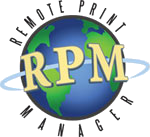
Print clients connect to RPM Remote Print Manager® (RPM) and send print jobs exactly as they do with any printer or print server. RPM supports two common print protocols: LPD and telnet.
You can replace your current print server with RPM and all will be fine.
LPD
If you print now using a hostname, IP address, and queue name, you use LPD. You must get the IP address of the computer where you've installed RPM. We show you how to do this. Then use the same queue name you are already using. Queue names are not case-sensitive, and RPM will create a queue if it doesn’t exist already.
Telnet
The second protocol is telnet, also called “reverse telnet”. If you print to port 9100 now then you are using telnet. There are only a few configuration steps in RPM, and we show you how
With telnet, we support the two common methods for delineating jobs. Many print clients open a connection, send the print job, and then close the connection. We support this, of course. The second method is sometimes called the “quiet period”. If the connection pauses for a given length of time, then RPM will print everything received up to this point, and then listen for more data. With RPM you can configure how long this period will be.